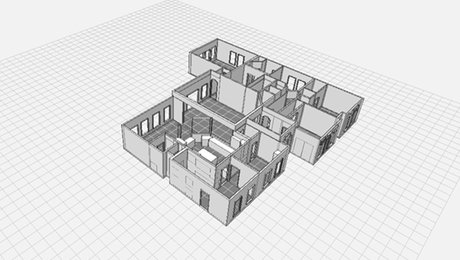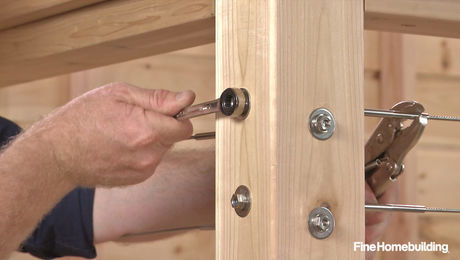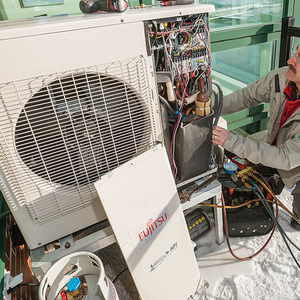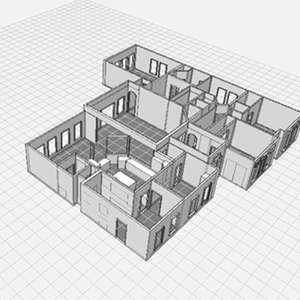Mixed gauge wiring on 20 amp circuits
Just moved into a 10 year old house. It has a 200 amp main panel with all 110 volt circuits having 20 amp breakers. I think great. Then while I was painting a bathroom I noticed 14 gauge wire leading feeding the vanity lights. Uh oh. A quick inspection of the crawl space over the garage revealed both 12 and 14 gauge wire in the same circuit. (The lights and outlets in the garage are on the same circuit.) So, what to do? Right now the plan is this:
1. Map the circuits in the house (most of the breakers aren’t labeled)
2. Inspect the gauge of the wire leading into the 20amp breakers of the main panel.
3. Replace the 20 amp breakers for circuits that are not required by code to be 20 amp circuits. ( All lighting circuits and outlet circuits in the living room, dining room, etc)
The question is what should I do about circuits that are supposed to be 20 amps by code (kitchen outlets, refridgerator, washing machine, bathroom outlets)?
Has anyone run into this before? All the wiring appears to be original. It’s hard to believe this passed inspection.
Any suggestions.
Thanks
Adam



















Replies
Inspectors are pretty tight around here concerning electrical work. I think most of them must be ex-electricians, so you GOTTA have that right. That said, most circuits in my house (built for resale, not something I'll stay in for more than 4 years) are 14ga. But every 120 breaker in the main panel is a 20. Go figure.
For fire safety, the breakerr must be sized to protect the WIRE.
14ga will/may get hot enough to start a fire with a continuous load of near 20A.
ADAM, If you find a 14ga on a circuit that must be 20A, break the connection between the 14 and the 12 and run new 14 to reenergize the 14ga leg.
ProBozo, rreplace all 20A breakers (all14ga in your house?) with 15A's. You should replace required 12ga circuits with 12ga wire.
EDited: PB, just reread your post, just replace the 14ga circuits with 15A CB's.
JohnnyD, you time crossed me, the lamp cords are visible and unlikely to short without someone being the cause, therefore present when the short happens.
Be safe
SamT
Edited 8/28/2003 9:41:33 AM ET by SamT
Sure is tempting to mix 14 AWG and 12 AWG on the same circuit (which of course I never do), but I've never been able to figure out exactly why. I mean, what potential harm is there in a mix? Afraid the 14 gauge will melt before the 20 amp breaker trips whereas if it was on a 15 amp breaker everything would be OK?
Somehow doesn't make sense to not be able to run a few feet of 14 gauge from an outlet which is on a 20amp circuit and wired with 12 gauge to a light switch and on to the light when for example a lamp cord can be 16 or even 18 gauge and then plugged into a 20amp circuit wired with 12 AWG.
Do they figure the lamp cord will cool off quicker or not have the potential to heat up as much as 14 gauge buried in a wall?
Is there a history of fires or other accidents when gauges are mixed like this?
Sometimes it would help to know the reasoning behind the code.
Not totally sure the reasoning behind the code. Here's mine.
I do know that wire that's buried in your attic insulation, or in the wall is unlikely to be able to cool like a lamp cord would be. Also, the designer of the lamp cord can design it for a specific load. Nobody's likely to plug a tablesaw into the lamp socket (though I've seen it done).
The biggest danger though is that someone will plug a high draw buffer, tablesaw, pressure washer, whatever into that outlet. Thus putting a high draw on that wire.
Of course, outlets are also often ran in strings, so it'd be entirely possible for the wife to plug a space heater in in one room, while the kids run a tv in another, and the daughter plugs a hairdryer in in the bedroom. The loads can quickly add up over 15amps and overheat the wire. Even if this doesn't cause problems then, the heating/cooling can loosen connections and lead to future problems.
I'd swap all breakers with 14 gauge wire to 15 amps. And, rewire any going to outlets if possible.
Thanks for your response...so:
"wife to plug a space heater in in one room, while the kids run a tv in another, and the daughter plugs a hairdryer in in the bedroom. The loads can quickly add up over 15amps and overheat the wire."
In that senario, with 14AWG and a 15 amp breaker, the breaker would pop before the wire would heat up?
In the senario I invision, if you ran 12AWG from a 20 amp breaker to an outlet, and then pigtailed 14AWG off the recepticle up to a light switch and then on to an overhead light rated for a 100 watt bulb...how would you ever put an over heat load on that 14 AWG? I suppose someone could put a screw-in female plug in the socket and then plug a big space heater in, but not very likely. That's why we have to have enough outlets on every wall etc...so no one is ever tempted to do something stupid or dangerous.
Don't get me wrong, I always follow the code and my work passes inspection, just wondering.
Edited 8/28/2003 10:54:20 AM ET by johnnyd
In reality your scenario is safe. If there's nothing downstream of the light. And, if everything works right. Sure, you're unlikely to ever pull more then 100 watts through that wire. But, what if you get a loose connection and it starts arcing? Or the light holder shorts out a bit? It'd be possible for the circuit to pull 20 amps through that wire just because of malfunctions, which could cause a fire, where if it tripped at 15 amps there wouldn't be one.
Of course, it'd be just as safe to put 18 gauge lamp cord in the wall since you're only running 100 watts, right??
That's why the code isn't real flexible. The breaker is there to protect the wire in case something doesn't work right. It's possible for a bulbholder to short acrost so that current can travel but with heavy resistance. This creates lots of heat at the fixture which is bad, but if it also creates heat in the walls because the wire's undersized it's worse. Lots of funny things are possible. What isn't likely is for the wire to get too hot with only 15 amps of current flow.
Great....that's exactly the reasoning I was looking for.
There may be other neo-phytes out there with thinking along these lines...this will help them make sure they do safe work too.
If anyone has noticed the new type NM wire on the shelves at the big boxes, they are now color coded for 10, 12, and 14 ga. wire. Makes life easier for the inspectors.
I expect to see the color coded wires to become part of the NEC on the next revision in 2005.
Dave
Actually it is legal to connect #14 wire to 20 amp #12 wired circuit.
They are called tap wires, but they are limited to 18" and a few specialized applications.
And smallere taps are allowed for where you have a separate cooktop and oven connected to a single branch circuit.
And even #16 wires (and maybe #18) can be connected to #12, 20 amp circuit. They are fixture wires. In all of these case the wires are hidden. But one of the main things that these are all "controlled" usages.
And I agree that the lighting fixture example using #14 for the lighting leg is safe. They main thing with trying to get this in the code is that there are already so many special cases and it is would be an easy place for some one to "cheat some more".
BTW, a few local areas are requiring ALL 120 volt branch circuits to be 20 amp.
AFA the 18 guage lamp cord pluged in the code does not conver it. The code is not designed to protect the loads, but rather the wiring and fixtures.
And there is not much possibility of having any problem with a lamp with a 60-100 watt bulb.
But you can get 18 - 16 guage extension cords and plug a 1500 watt heater in.
Thanks for your input...another question, have you ever used the GB heat shrink splice kits? Look like good units...brass and plastic screw connectors with a big tube that is supposed to heat shrink around the connectors and the UF cables on both ends. Says it's rated for direct burial.
Any tricks to get a reliable waterproof seal with these units?
Sorry never used them.
But I know that there are ones speced for those kind of repairs.
heat shrink splices are used on submersible pumps... EliphIno!
First the obvious: These splice kits are for buried cables only. There is a similar kit that does individual conductors for direct burial or use in wells. Neither of these is suitable for wiring in a structure. When properly used and protected by a well casing or two feet of dirt there is little danger of causing a fire if these units fail. I have seen them used in place of a junction box by people who don't know any better. Misused and forgotten in a wall these units could represent a significant fire risk. They are not an alternative to installing an accessible box and proper connections.
I use these units quite a bit, a couple of times a year, and keep two or three kits on my truck. Given a choice I like the ones with an inner heat-shrink sleeve that doubles the amount of plastic between the bulky splice adapter and the dirt. If I get one without a inner sleeve I wrap the core tightly with several layers of tape before shrinking on the outer sleeve.
The reason being that the plastic core that hold the brass splice tubes commonly has projections and points that can eat their way through the sleeve from the inside. Particularly if the splice is surrounded by rocks or roots. I have seen them fail due to this.
Tips: A silly but common mistake is to forget to slip the sleeve/s over the cable before making the connections. Makes you undo everything to get the sleeves in place.
Don't strip the cable jacket too far back. You only need enough separate wire to get lined up with and into the brass sleeves. The longer the jacketed run under the heat shrink sleeve the better the seal is likely to be.
Don't strip the wires too far back. Just enough to have bare conductor in the brass sleeves is right. Insulation up to but not in the sleeves is perfect.
Check the set screws in the core before messing with the cable. Sometimes one or more will bind up. Easy enough to fix while standing at the truck it can be a pain when you are standing on your head in the rain. Often a drop of WD40 will get it working properly. This is also important because you tighten these tiny set screws by feel. A bound up set screw feels like a properly tightened one but leaves a loose connection likely to overheat and fail.
Do not get carried away tightening up the set screws. They are tiny, usually 8-32 I think, and threaded into a thin brass tube. If you horse them down they will strip. So tight enough but no more. Judgment and experience is the key. The set screw should dimple the copper conductor but no more. If you plan on doing a few of these experiment at the truck in good weather. Many times you will only need three connections on a four connection kit so go ahead and strip one out so you know how far to go. Once you mess up one sleeve remove the brass tube and save it and the set screws for spares. I do this with helpers.
Double check the phasing, order of wires, before messing with the sleeves. You can often correct this problem without reopening the splice by moving connections at either end but why get into it.
Bring a piece of cardboard, an old doormat or other material to keep the splice up out of the dirt while you work your magic. Dirt in the splice can cause the sleeves to leak and the connection to fail. This also helps keep your hands, boots and tools out of the mud. It also helps if a set screw falls out as they are tiny and easily lost in the dirt.
If the wind is blowing, I always seem to get these repairs when it is raining, a piece of plywood or similar can keep the wind off and make using a torch much easier. In heavy rain I have been known to throw the 8' by 12' tarp I carry on my truck over the hole and work underneath it. It also helps with nosey HOs.
Use a marker, keel or even a piece of tape to mark the planned location of the end of the heat shrink. Without a reference mark it is easy to get the sleeve too far to one end and barely making a seal on the other.
Dry the cables off before applying the heat shrink. A clean cloth and a bit of torch work gets it there. Clean dry surfaces make a better seal with the hot melt compound.
I have used an electric heat gun and even once, when caught without any other heat source, set a small fire in the bottom of the trench to provide heat for the splice. Both worked. The gun a bit better than the fire but given a choice a propane torch, preferably one with push button ignition, is what I use to form the heat-shrink.
When heating the sleeve work around the plastic core first to keep the sleeve from sliding. Once it looks like a bow tie work out toward the ends alternating between ends and flipping the joint over to get the back. Properly done there should be a nice bead of hot glue all the way around the cable at the ends.
Resist the urge to touch the glue. It is hot, sticky, holds heat for a very long time and causes painful burns. Napalm has nothing on this stuff.
Expect to use two kits. Typically the cable run is to a well or out building and was run too shallow. Roto-tilling, post hole digging or trenching in pipes or cables cuts the cable. Sometimes it will fail months or years later but usually, unless the break is near the end there is not enough slack to make a splice so you need to add a length of cable and two splice kits.
Don't forget to check the cables before trying to splice them. Just because you find a place where the cable is broken don't assume it is the only spot. I once got a call where a man had aerated his lawn and found his garage lights didn't work. We spliced the line only to find out that the garage still had no power. The cable was cut in four places and damaged in at least six. It had been buried only two or tree inches deep. We pulled the shredded cable up, it came up quite easily through the sod, and dug in a new one at a more appropriate depth. With multiple breaks it is often better to replace the run.
All this makes it sound complicated. There are lots of details but most are common sense once you get into it. Maybe these tips will save someone having to learn them the hard way like I did. Not that I didn't have fun screwing up just about every way possible. So it goes.
JohnnyD
This is what I learned in the Navy while on an undersea cable layer, if it works under water, it should work underground.
First clean the splice are for about a foot on each side with a nonresidue cleaner like brake cleaner or dry alcohol.
Starting at the center of the splice with rubber tape wrap to one side using %50 stretch and %50 overlap to 4 cable diameters past the start of undamaged insulation, reverse direction to the same point on the other side, reverse again back to the center. If the tape breaks or you have to use another piece, restart 4Dia before the break.
If there is a big uneven lump at the splice use the rubber tape to feather it out before starting the wrap.
Using the same center-to-end-to-other-end-to-center pattern (for all layers of tape), wrap with friction tape to 4D past the first layer (all layers will go 4D past the previous).
Paint the friction tape with liquid tape (+4D). After that dries, wrap with a GOOD vinyl tape (3M 333) 4D past the liquid tape using the same %50/%50 that you did with the rubber tape. Paint the vinyl with liquid tape (+4D)
Keep everything clean and avoid wrinkles.
Repeat the whole process. This is what we did for up to 1000 feet deep.
When I installed underground cable TV, I never had a problem with a splice done this way, but the EXPENSIVE gooey centered heat shrink was only good for about 6 months.
SamT
Heretic, Blasphemer. ;)
Everybody knows that the only way to get a good underground splice is a seven layer hand wound tape job and lead wipe. Of course you have to dig a four foot square hole three feet deeper than the cable and it takes two hours per splice, usually it takes two splices. So about five hours minimum, $70 per hour, and $50 in parts, $25 in tape and lead and $25 in propane to feed the lead pot and rosebud. Worked on a few of those jobs but $400 seems a bit steep for a repairing a run of 10/2 UF cable running a well pump even if your thirsty but it is your call.
Splice kits have improved in the last 20 years. Gel is largely gone. Now, early version have been available since the 70s but they have improved since then, it is hot melt glue lined heat-shrink tube. Sure if sloppily done these are no better than the old standby (circa 1930s), an orange juice can filled with roofing tar with wire nuts pushed down into it and topped off flush with a trowel. Some old timers used axle grease, this was long before a UL listed solution was available. I have seen a few of these tar jobs still going strong after 60 years below the water table.
Once a hole is opened up, wide enough for my arms and a few inches deeper than the cable, I can complete a set of splices in about 20 minutes. Even with charging $24 for for each $12 kit, standard mark up, your looking at about half an hour, $35, plus $48 parts or $83 plus a bit for diagnostics and finding the break. Most people find this much more reasonable to get the well pump running.
I have done many of these splices and unless the splice was improperly done, rare but I'm human, crushed or dug into they last even when underwater. Of the hundreds I have done I haven't had more that one or two fail.
In a pinch I still sometimes hand wind a splice. Particularly on larger conductors Scotch 33+, splice putty, rubber filler tape and Scotchcote can yield a long lasting and effective splice but it takes time, more room to operate and keep the splice clean and is considerably more difficult to complete effectively in lousy conditions. UF splice kits are quick and effective if care is taken this saves the customer money. You get the same guarantee either way. One year parts and labor.
"Some old timers used axle grease, this was long before a UL listed solution was available."
Hey, they still do, and it is approved. They just changed the grease to silcon. But of course it is only for LV.
BTW, I would like to see someone do a lead wipe on UF.
"The question is what should I do about circuits that are supposed to be 20 amps by code (kitchen outlets, refridgerator, washing machine, bathroom outlets)?"
What code are you talking about?
First of all there is no requirement for a 20 amp circuit for the refigerator.
I would be more concered about match the code when the house was built.
I believe that the 20 amp circuit for the bath recp is fairly new. Don't know how logn the laundry circuit has been required.
But it appears that you have access to a fair amount of the wiring, so where needed you either replace the #14 or separate them off to a different branch circuit.